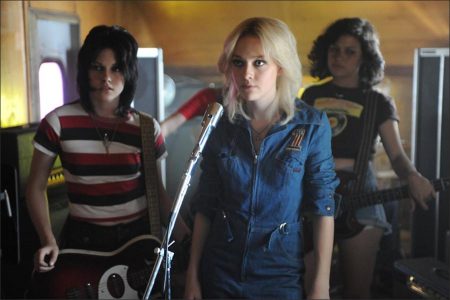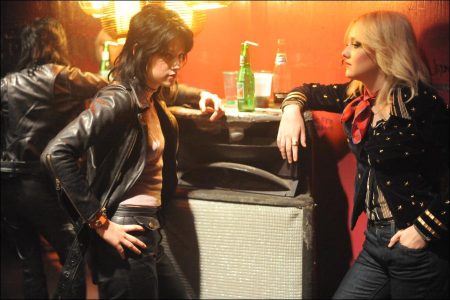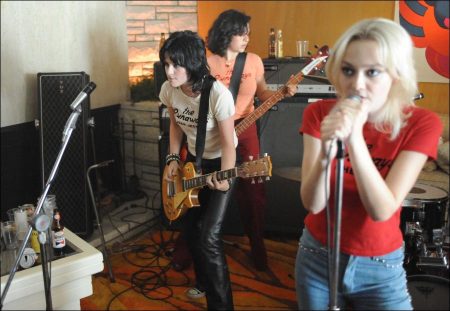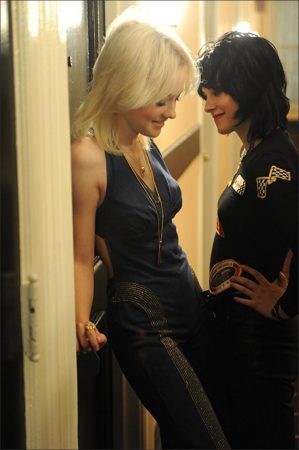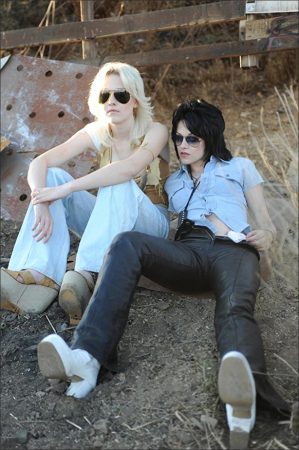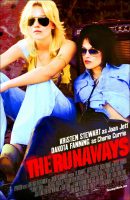All About The Runaways
Summer 2009, Kristen Stewart transforms into a fiery red leather jumpsuit-wearing, guitar-strumming powerhouse. Immediately to her right, Dakota Fanning is now a glam rock star, wearing a tight corset and fishnets. The crowd goes wild as the band rips into the thunderous “Cherry Bomb,” The Runaways’ biggest hit.
The hyper-realistic moment is something far more than actors filming a scene: Fanning is really singing and Stewart is really playing as tears begin to fill the eyes of the real Cherie Currie and Joan Jett, who are watching their lives play out thirty years later. The fans are pretending to cheer for The Runaways but are sincerely star-struck at the site of Fanning and Stewart.
Raw truth and authenticity prevail as Floria Sigismondi directs the camera to capture the moment at every conceivable angle. For the characters it is the apex of their journey. For the young actors, it is near the end of an intense month-long shoot, where they have been challenged by the grittiest, and perhaps deepest, roles of their careers.
Sigismondi wasn’t interested in making a biopic or celebrating the past. She saw The Runaways as a way to tell a story of empowerment where young girls come into their own and set out to make a place for themselves. “It is a coming of age story of young women kind of getting in too far deep into, and kind of surviving, their time together,” said Sigismondi. “They just get too far, lost in their circumstance. But it is not a documentary. I have taken liberties with trying to depict the truth through the events, and finding a story beyond what we know.”
This story was four years in the making- beginning with producer John Linson (Lords of Dogtown) who licensed the rights to Currie’s book and set out to get this movie made. Growing up around the entertainment business and the music industry (his father is renowned producer Art Linson- Fast Times at Ridgemont High, The Untouchables, Heat- also a producer on The Runaways), John Linson was particularly versed on the toll fame can take, especially on youth.
He was at a party talking music and the name Cherie Currie came up. Cherie was someone Linson admits to “having a bit of a crush on” when he was a young kid reading the wild tales of The Runaways in “Creem” magazine. As the others conversed about the impact of The Runaways on music, Linson was struck with the idea of “making a movie about two young girls who go up against Hollywood.” To do The Runaways justice, Linson knew this wasn’t going to be some PG-13 sugarcoated version of the band that quells the racier parts of the story. “It wasn’t as much to do a music film as much as a teenage girl powered drama that tells the truth of what life can be and not be in LA,” Linson continues.
To make the movie they wanted to make, the Linsons needed the right backing from a production company that was unafraid to produce films that fly in the face of studio formulas and convention. They didn’t have to look far to find River Road Entertainment, given Art Linson had just produced Sean Penn’s acclaimed adaptation of Jon Krakauer’s Into the Wild, based on the life Christopher McCandless and his extraordinary journey into the American West. For a company that has made a number of “true stories,” River Road is not interested in simply recreating the past. The company aims to produce films that stand the test of time in the sense that they are more about the characters’ progression and the broader meaning of their lives as much as the individual beats along the way.
The Linsons and River Road founder Bill Pohlad were in sync on the angle of The Runaways story. “It has to be about the people,” said Pohlad. “It is about girls, and the ability even at that young age to try to find yourself and try to cut something out of life for yourself as opposed to just being part of a pattern or falling into one trap or another.”
While it wasn’t essential, finding a female director was important to the producing team, given the coming of age nature of the piece. After talking to a number of different prospects, for more than a year and a half, they found Floria Sigismondi.
“We certainly knew of Floria and her music video work,” offers Pohlad. “We were all very drawn to her, and it’s turned out incredibly well. She dove into the material, and certainly had a strong connection to it. She’s very confident with a very strong vision, and is somebody with great visual sense and a great eye.”
To prepare to write the screenplay, Sigismondi conducted numerous interviews with band members and people close to the scene. She also researched band profiles from the era and pulled from Currie’s book. With all this material, Sigismondi was able to imagine teenagers wrestling with all that comes with a red-hot spotlight. “To get their voices I did a lot of historical research,” said Sigismondi. “And then I drew from my own past and thought of how I would have felt in a similar situation. And it went from there…”
At their core, The Runaways were a band about liberation- liberation from stereotypes, liberation from the banality suburban life, and liberation from the corporate rock and disco sounds that dominated radio.
Of course the rock scene of the 1970s was certainly not without its lurid tales of excess and illicit drug use and The Runaways did not escape it, which Sigismondi felt made their band’s success all the more moving.
“It wasn’t, you know, like these are the accomplishments,” said Sigismondi. “I think the accomplishments come through the pain. Cherie is triumphant to me because she makes a choice. And Joan’s triumphant because she makes another choice. But to me they are both heroes because they are both following their heart. But in all that, it was hard to get to that place. So for me it wasn’t just about the highs, it was about everything, including the lows.”
For Sigismondi, there weren’t many young women who could play Joan Jett and truly embody her character from the voice, to the personality, to the body language like Kristen. Stewart was at the right age and point in her life to identify with Joan and make the deep connection to her character. “I think Kristen became her,” said Sigismondi. “Her essence was so true; it was really an amazing transformation to behold.”
It’s rare for actors to have such immediate access to the person they are portraying. During production, Stewart and Fanning were often seen off to the side on sets, in the trailers, even outside of production working closely with Currie and Jett to hone every detail of the rock and roll personas. To carefully craft her performance to be an accurate reflection of Joan, Stewart spent a great deal of time with Jett throughout production of the film.
“Joan’s our executive producer; she was there every day spending time with me,” said Stewart. “To prepare for a role like this, you can research, read interviews, watch old footage, but to my benefit, there wasn’t a whole lot of that available. I was able to talk directly with Joan and think I would have felt like a fraud had I not.”
As Dakota took the stage for her pivotal “Cherry Bomb” scene, waiting in the wings was her biggest supporter and fan. “To me, Dakota is just one of the greatest actresses ever,” said Cherie Currie. “She was so engaging and eager to make sure she was on point with her singing and her performance. She’s phenomenal.” Being the same age as Cherie in the film helped. Since Dakota felt like Cherie’s contemporary this gave her the ability to identify in greater depth with her character. “I was very lucky to have Cherie help me understand the character,” said Fanning. “I was able to ask her questions that led to stories about my character and gave me more background, gave me an extension of what was on paper.”
Kristen and Dakota captured the energy, anger, and youthfulness of these young girls, committing to voice lessons, with Kristen diligently learning how to play the guitar. Michael Shannon recalls her saying, “I don’t want to look like an idiot up there. I don’t want to fake it. I want to be able to play these songs.” Stewart mastered all 12 pieces and had perfected phrasing of the words to mirror Joan’s when singing the songs.
The film reminds us that The Runaways arrived during an extremely crucial moment in time for women in music and the film eloquently captures the music scene in Los Angeles in the early to mid 70s. “Everyone wants to believe that the extraordinary can happen to them,” says Currie. “It doesn’t mean you’re not gonna have to work hard for it, because, trust me, a lot of people never thought we could do what we did. We went through hell making it easier for girls in music. We were the soldiers out there getting bloody and beat up. But here we are. And we’re doing okay.”
A Brief History of The Runaways
Summer 1975 – 15-year-old Joan Jett is spending her free time at Rodney Bingenheimer’s English Disco in Hollywood getting turned on to glitter rock like David Bowie, Gary Glitter, and T. Rex. Around the same time, Sandy West, whose passions included surfing and drums, approaches Kim Fowley, another frequent fixture at Rodney’s, about forming an all girl band. Kim brings Joan and Sandy together and agrees to help them find other girls to join the band. By August the band grows to four members with Micki Steele on bass and Lita Ford on lead guitar. Lita had originally auditioned for the bass player, but since the position was already filled, ends up as the band’s lead guitarist. With Kim as their manager, the three-piece band decide on the name, The Runaways, and within a few weeks they play their first show at a local party.
Fall 1975 – The Runaways play their first public show at the famed Whisky-A-Go-Go in Hollywood.
November 1975 – Joan and Kim meet twin sisters Cherie and Marie Currie, not yet 16. Cherie auditions for the band with no song to sing. On the spot, Joan and Kim write “Cherry Bomb.” Singing the newly written song, Cherie lands the job and becomes the lead singer. Shortly after, Micki Steele leaves the band and is replaced by Peggy Foster. By December, Peggy is replaced with Jackie Fox.
February of 1976 – The Runaways sign to Mercury Records and soon enter the studio to record their debut LP, The Runaways. After their first album is released, the band embarks on their first U.S. tour. Highlights included the famous Agora Ballroom in Cleveland and CBGB’s in NYC. The band then embarks on their first European tour. They returned to the U.S. and continue to tour. Highlights included the Royal Oak Theatre outside of Detroit with opening acts Cheap Trick and Tom Petty and The Heartbreakers.
1977 – The Runaways second album Queens of Noise is co-produced by Sparks’ guitarist Earle Mankey. Upon wrapping recording, they hit the road for their second US tour. Meanwhile, The Runaways are exploding in Japan. “Cherry Bomb” hits #1 in Japan and Australia, and they become the fourth biggest selling act in Japan. The mass hysteria of the arrival of the Runaways in Japan, for their sold out tour, rivals the arrival of the Beatles in America. Jackie quits the band and flies home to the states. Joan picks up the bass for their biggest show to date, The Tokyo Music Festival. They released, Live in Japan, which becomes one of the highest selling imports of the `70s.
Winter 1977 – After returning home, the band returns to the studio to work on their third album, Waitin’ for the Night. The band’s lineup changes again, with Vicki Blue joining to replace Jackie Fox. Joan takes over lead singing duties replacing Cherie Currie, who leaves to pursue a solo career. Waitin’ for the Night is the first release with Joan Jett on lead vocals. By the end of the year, the band parts ways with manager, Kim Fowley.
1978 -The Runaways find new management and begin to record their fourth album. They head to the UK to begin work on And now…. The Runaways. Once again, they have to replace their bass player, after Vicki Blue falls ill. Laurie McAllister joins the band and The Runaways begin their final tour, ending with New Years Eve at the Cow Palace in San Francisco.
1979 – The Runaways decide to disband because of creative differences but not before leaving an indelible mark on rock and roll and paving the way for a number of all-girl groups to follow, including The Go-Go’s and The Bangles.
The Runaways (2010)
Directed by: Floria Sigismondi
Starring: Kristen Stewart, Dakota Fanning, Scout Taylor-Compton, Stella Maeve, Alessandra Torresani, Hannah Marks, Alia Shawkat, Riley Keough, Johnny Lewis, Tatum O’Neal, Allie Grant, Jill Andre
Screenplay by: Floria Sigismondi
Production Design by: Eugenio Caballero
Cinematography by: Benoît Debie
Film Editing by: Richard Chew
Costume Design by: Carol Beadle
Set Decoration by: Fontaine Beauchamp Hebb, Mark Walker
Music by: Lillian Berlin
MPAA Rating: R for Language, drug use and sexual content – all involving teens.
Distributed by: Apparition
Release Date: March 19, 2010

